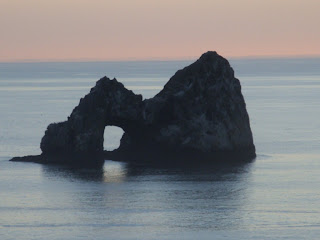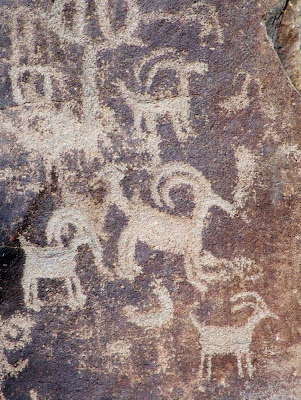Tsagaglalal and Temani Pesh-wa
"She Who Watches" and "Written on Rock"
Gorge petroglyphs moved to place of honor
(Story excerpt from the Sunday, March 28, 2004 Oregonian Newspaper article by TERRY RICHARD)
Photo's by me...Steven Michael
Nearly a half-century ago, rising waters behind The Dalles Dam forever changed a wild stretch of the Columbia River, submerging salmon-rich Celilo Falls, the Long Narrows below it and hundreds of ancient sacred petroglyphs.
The surrounding lands long had been a gathering place for people from the Warm Springs, Yakama, Umatilla, Nez Perce and other tribes. Some lived there permanently, while thousands more visited seasonally to harvest spawning salmon, to practice their religion and to join the annual opportunity to trade and socialize.
The petroglyphs -- drawings that were chipped or ground into rock to depict tribal legends, hunting scenes and mysticism -- are evidence of these gatherings. One narrow slot just above the river had so many thousands of drawings that it was named Petroglyph Canyon.
But as the reservoir rose behind the new dam, most of these rocks were covered by water. A few were pried away and stored at the dam, perched against a wall of the fish ladder beneath roosting birds -- not a fitting home for what tribal elders consider sacred icons that provide a cultural connection between modern people and their ancestors.
A plan to give them a more fitting, permanent home took shape in 1996, and eight years later 43 petroglyph-covered rocks have been moved to Washington's Columbia Hills State Park.
Formerly called Horsethief Lake, the state park is indisputably the best place to see native petroglyphs in the Northwest. The park is also home to Tsagaglalal, "She Who Watches," one of the most famous rock images in North America.
Because of past vandalism, viewing of the Tsagaglalal image is limited to an escorted tour twice a week by the Washington State Park service.
"Jody Heath, was my guide. It was very obvious that Jody loved sharing her heritage with others, and she also respected the land in a spiritual manner."
The famous Tsagaglalal, "She Who Watches", Native American rock art is a combination of two styles, a petroglyph (carved into the rock) and pictograph (art drawn or painted onto rock). There is a legend about the art's origin that is hauntingly prophetic of the impact humans have made on the earth.
"There are several versions of the legend, but the one that was told on the tour was by the Wishram people:"
"...After a time Coyote in his travels came to this place and asked the inhabitants if they were living well or ill. They sent him to their chief who lived up on the rocks, where she could look down on the village and know what was going on.

Coyote climbed up to the house on the rocks and asked "What kind of living do you give these people? Do you treat them well or are you one of those evil women?" "I am teaching them to live well and build good houses," she said.
"Soon the world will change," said Coyote, "and women will no longer be chiefs." Then he changed her into a rock with the command, "You shall stay here and watch over the people who live here."
All the people know that Tsagaglalal sees all things, for whenever they are looking at her those large eyes are watching them.
A petroglyph trail named Temani Pesh-wa, (Written on Rock), displays petroglyphs on their original slabs of rock and leaned up against a natural rock formation. Vegetation is slowly growing around the petroglyphs, giving the man-made display an increasingly natural atmosphere.
Chipped into 5-foot-long rocks, the petroglyphs are easily visible. They depict deer, mountain sheep and the humans who hunt them. They show thunderbirds, owls, fish and a mysterious creature with long flowing tentacles.
Facing east upriver, the rocks sit within a mile from where most were taken in Petroglyph Canyon. The canyon is covered by Lake Celilo, the impoundment behind The Dalles Dam.
When the rocks were removed from storage at The Dalles Dam, they were swathed in natural fibers and trucked in a bed of gravel for protection. None was broken during the move.
When members of the Lewis and Clark expedition passed through in 1805, they noticed a settlement of 1,500 at Big Beach in the future park. Before construction of the dam, the Columbia was placid and wide as it passed the settlement, then seemed to turn on its side as it rushed through the Long Narrows with what Clark described as a "bad whorl and suck."
The river's transition afforded a natural setting for large gatherings during late summer. The Native Americans harvested huckleberries nearby at Mount Adams, speared salmon from the Columbia and staged games on one of the rare flat spots along the river.
And, they chipped designs on the rock walls of the canyons. Some of those images finally have been given a home that closely matches the respect, awe and wonderment felt for their original site by their creators.
"Seeing and learning of the historic native ways, and culture, allowed me to appreciate the diverse regions found within the Columbia River Gorge. The petroglyph's and pictograph's within the park are a" must see."
To get there, from Interstate 84 take Exit 88 for The Dalles Bridge. Cross north into Washington and drive three miles to State Route 14. Turn east and drive 1.5 miles to the park's entrance.
 Nature at its Best!
Nature at its Best!
 When the conditions are just right, which requires a high surf, the right tide level, continual wave action, low wind, a sunny day, and hitting the offshore rocks in the right place at the right time, magic happens.
When the conditions are just right, which requires a high surf, the right tide level, continual wave action, low wind, a sunny day, and hitting the offshore rocks in the right place at the right time, magic happens.
 The rugged cliffs of Shore Acres rise between 80 to 100 feet above the sea. From November through January it is not uncommon for storms to generate these incredible, powerful, earth shaking works of natural beauty.
Crashing waves often tower 150 to 200 feet into the air, and can douse the Sitka Spruce
The rugged cliffs of Shore Acres rise between 80 to 100 feet above the sea. From November through January it is not uncommon for storms to generate these incredible, powerful, earth shaking works of natural beauty.
Crashing waves often tower 150 to 200 feet into the air, and can douse the Sitka Spruce  forest 200 to 250 feet away.
A Shore Acres Wave is an awesome display of power.
Over the Thanksgiving weekend, the Shore Acres Wave came to life. What made this event so unique from any other wave event is, there was no storm hitting us. The high surf advisory was generated from storms
forest 200 to 250 feet away.
A Shore Acres Wave is an awesome display of power.
Over the Thanksgiving weekend, the Shore Acres Wave came to life. What made this event so unique from any other wave event is, there was no storm hitting us. The high surf advisory was generated from storms  that hammered southern California. It is rare to witness this event with 70 degree weather, and no wind. The day was very perfect.
This photo illustrates the aggressive power behind the beauty. The "triangle rock" stands 80 feet. Ominous crashing waves devoured the rock shortly after I took this photo.
(Look at the first photo again...on the right side of the photo, you can see spectators enjoying the majestic show.)
that hammered southern California. It is rare to witness this event with 70 degree weather, and no wind. The day was very perfect.
This photo illustrates the aggressive power behind the beauty. The "triangle rock" stands 80 feet. Ominous crashing waves devoured the rock shortly after I took this photo.
(Look at the first photo again...on the right side of the photo, you can see spectators enjoying the majestic show.)


 The adjacent rocks and islands host the second largest concentration of nesting seabirds in Oregon, with over 200,000 birds present from April through September. The headland contains rare native plants, unique geologic formations, one mile of undisturbed shoreline with extensively rocky intertidal areas, and a small stream containing native cutthroat trout.
The adjacent rocks and islands host the second largest concentration of nesting seabirds in Oregon, with over 200,000 birds present from April through September. The headland contains rare native plants, unique geologic formations, one mile of undisturbed shoreline with extensively rocky intertidal areas, and a small stream containing native cutthroat trout. 






 Harbor Seals,
Harbor Seals,







 Approximately 9 miles up the river drive we came across, what I would call the jewel of the Yachats River, the historic red North Fork Yachats Covered Bridge. This beautiful covered bridge was built in 1938, with a Queenpost truss, one of the few of this type remaining in Oregon, and was restored in 1989.
Approximately 9 miles up the river drive we came across, what I would call the jewel of the Yachats River, the historic red North Fork Yachats Covered Bridge. This beautiful covered bridge was built in 1938, with a Queenpost truss, one of the few of this type remaining in Oregon, and was restored in 1989.  The setting, a red bridge, a gravel road, a thick matted shaded forest, made me feel like I was in a fairy tale land. It wouldn't have surprised me if we witnessed a hobbits, or friendly trolls, and perhaps leprechauns going about their business. No such luck though.
The setting, a red bridge, a gravel road, a thick matted shaded forest, made me feel like I was in a fairy tale land. It wouldn't have surprised me if we witnessed a hobbits, or friendly trolls, and perhaps leprechauns going about their business. No such luck though. 





















